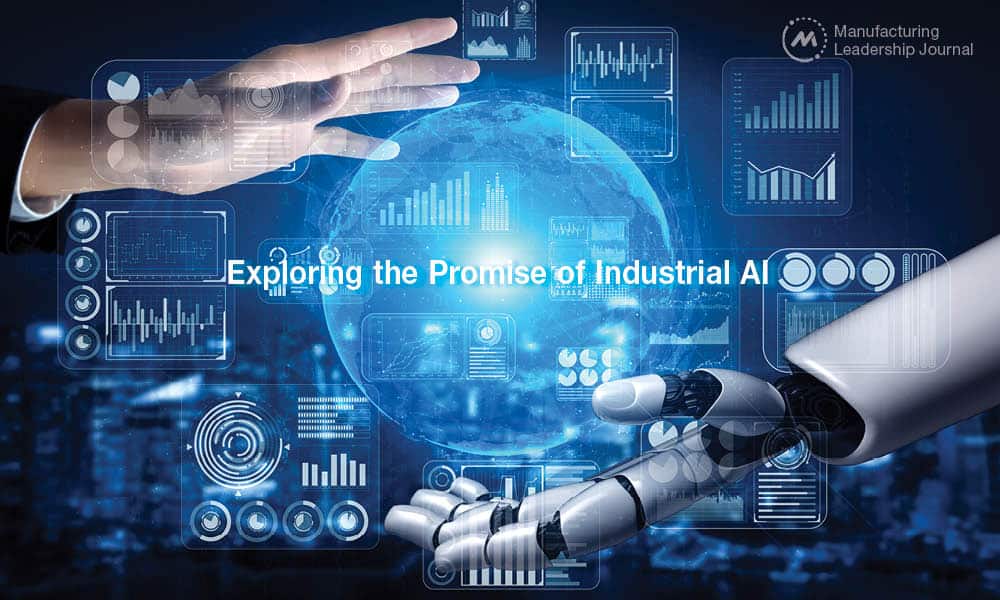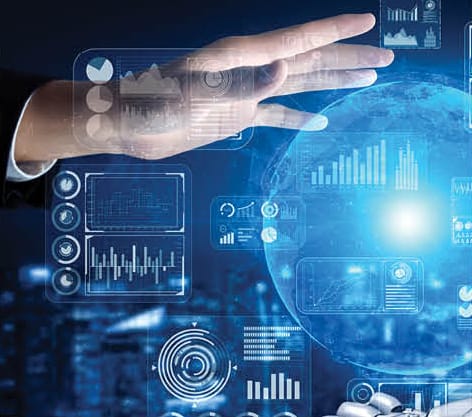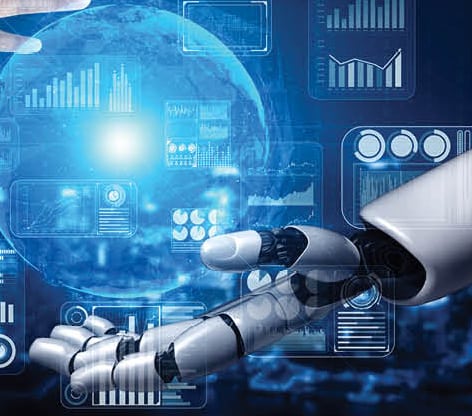M2030 Perspective: Exploring the Promise of Industrial AI

AI promises to foster a mutually augmented human-machine relationship, making the workforce more productive and strengthening manufacturing capability.

Artificial intelligence is already becoming a commodity tool that is permeating our lives. If you have used Google maps, Apple maps, or shopped on Amazon, then you have already been touched by AI.
Driven by Data
AI is essentially the simulation of human intelligence using computers. Machine learning (ML) is a subset of AI that is used to automatically learn from data without being explicitly programmed. The two key words here are simulation and data. While we’ve all heard about the great promise of AI, it is still a simulation of human intelligence. Right now, human intelligence is superior to artificial intelligence in many sectors, and certainly in manufacturing. Part of the reasoning here, is that AI has yet to be trained in the vast field of manufacturing. Such training requires data. One thing that we do know from manufacturing is that we have significant levels of automation, and that automation has serious amounts of sensors and sensing capabilities on board. So, while there is still much to be learned about AI in manufacturing, we do have substantial amounts of data for that training.
Understanding the Opportunity
Many initial forays in using AI in manufacturing have been tried. One approach is to take all of the data coming from manufacturing operations and feed them into commercially available AI algorithms to find patterns linking various elements of the manufacturing process to the outcomes (e.g., quality, process health, and the tuning of operations). Many of these attempts are what one would call “black box”, in that they are basically just throwing the data at AI systems to see what happens. This approach has had some limited success. However, more successful approaches have used data with models that are well established but augmented by AI. Augmented is the key word here. An AI augmented model approach uses models based on what we know about our manufacturing processes and supply chains and augments those models to yield more accurate and refined results.
For example, new generation design (CAD) tools employ AI to help design components based on variables such as the load requirements on a part, while minimizing its weight. The approach is generally called generative design, and it creates some very complex structures. One might think that such complex parts can easily be 3D printed – just hit the print button! – as we can now 3D print almost any geometry. However, a person with significant experience in 3D printing will tell you that this kind of print button does not exist and there remain numerous limitations on 3D printed parts. A part generated by an AI design alone may not, in fact, be printable. However, an expert who understands both the goal and the limitations can work with the AI system to generate a lightweight part that can effectively support the required load while still being printable. This is where artificial intelligence works together with real intelligence. The AI is augmenting the human designer, and the human designer is augmenting the AI in this instance. The key is that both are working together.
Improving the Models
Today, we are just starting to take our data and augment our models to help us better understand our processes. Within a few years, we will have improved models that better utilize sensor data to help us predict the future health of our processes. For example, higher end machine tool manufacturers are starting to place more sensors, such as accelerometers, on their spindles. They train their AI algorithms to understand the sensor output when the spindle is healthy, and then have the algorithms use that knowledge to determine if the spindle has developed a problem. Furthermore, the algorithms can often determine a pending problem, and when it is going to happen. So now, a plant might shut a machine down for maintenance in advance of a breakdown. Thus, repair might happen during the weekend, when the machine is scheduled for maintenance, as opposed to waiting for it to break at an inopportune time such as in the middle of a shift.

“AI has yet to be trained in the vast field of manufacturing. Such training requires data. While there is still much to be learned about AI in manufacturing, we do have substantial amounts of data for that training.”
Such applications of AI will not be a silver bullet. The interpolation/extrapolation limitations of AI will still be in place. That is to say, there is a good chance that AI will not do well outside the scenarios that generated its original training data. So, if a completely new problem or situation is presented to AI, its response can be highly unpredictable. Therefore, we will have to understand its limits. For example, there is no algorithm that can accurately predict when a spindle will fail, until the spindle starts to fail. Statistics can be used to estimate failure (for example, based on experience the spindle may be expected to last so many hours of operation), but until the actual failure starts to occur, one cannot use AI, or any other techniques, to precisely predict that failure. For example, statistically speaking, the spindle might be expected to last for 10,000 hours of operation. However, if a severe crash occurs, that life expectancy might be substantially shortened. That being said, if crash data are fed into AI models, we might get a better feel for how much time was taken off the spindle life due to the severity of the crash, so there is another instance where we can augment our spindle life model.
Augmenting the Human Workforce
Just as with automation, people often express concerns about AI replacing humans in manufacturing jobs. Certainly, we will not see the Skynet AI scenario from the Terminator movie series that is in total control. What we will see is that the AI will augment the human workforce making it more valuable and effective. So once again, rather than artificial intelligence, we will see augmented intelligence. Just as with the earlier generative design example, we can use AI to help the human workforce, and the human workforce can be used to train AI.
Mixed Reality AI
One great technology advancement that is presently coming on-line and will be fully integrated into manufacturing operations by 2030, is mixed reality, which is a blending of the digital and physical worlds. For example, in a plant many workers may have to wear safety glasses, so why not make them augmented reality (AR) goggles? Such goggles could ensure that an operator follows the right procedures and adheres to all the required safety protocols. It could also ensure the correct insertion of all of parts into an assembly. Such an approach is the best of both the human and automation worlds.
Automated assembly makes sense in a highly controlled environment when thousands or tens of thousands of assemblies are being made and the components of the assembly are always in the same location and orientation so that automated units such as robots know exactly where and how to put up these parts. But if a part is backwards or falls over for some reason, the robot may have great difficulty picking it up. A human, however, is very adept at determining a part’s location and orientation and picking it up to put into an assembly correctly. Furthermore, AR goggles could ensure that the person picks up the right components and puts them into the right locations. An added benefit to this, is that a digital passport can then be generated for the assembly that records the correct assembly procedure documenting every process step ensuring the assembly’s quality.

“Augmented is the key word here. An AI augmented model approach uses models based on what we know about our manufacturing processes and supply chains and augments those models to yield more accurate and refined results.”
Such a capability can also be used to help to train new workers in a facility and reduce their errors substantially, especially if the AR is used to train the AI by learning directly from the actions and decisions of experienced workers. This does not eliminate the human from the job, as a human is still necessary to physically execute the task. But AI could learn the most effective manner to execute a task and then guide a novice through a similar procedure using AR. All this can be done while building the product’s digital passport, conducting time and motion studies, and ensuring that all safety protocols are followed. It is truly an approach that augments and adds value to the workforce.
Privacy Implications
If we are recording every move and motion of the workforce, this does raise some privacy concerns which will need to be addressed in the years ahead. We will need to understand what we are learning and recording from the workforce and ensure that their data are protected accordingly. This is not unlike Google maps. We share our location with Google, and in turn, Google provides us with directions to where we want to go. Of course one major concern here is that Google might use our location data to track us and provide that information to third parties. The same is true in manufacturing. How do we ensure privacy among workers and businesses? This does open up a can of worms as, right now, different geographic regions (e.g., EU, U.S., China) have different regulations regarding personal data and its privacy. So, we will certainly have to address these issues which could become increasingly complex for multinational companies over the next few years.
Furthermore, the ability to share production data from one production facility to other facilities, or from one machine tool to another, is going to become important as lessons learned in one location could be equally as valuable to others at different locations. This highlights the value of data, but it begs the question, why would factory owners open their cyber doors to others and share their data? Clearly, new business and privacy models and rules must be developed to make it both worthwhile and safe for companies, and industries, to share some of their data.
Looking Ahead
So, I believe that by 2030 we are going to see AI capabilities permeate throughout manufacturing. We are also going to see it really take off in mixed reality settings that will increasingly look like something out of a science fiction movie. This will result in a safer, more efficient, and higher value-added manufacturing ecosystem. But it will also result in some very different business and socio-economic models that will change the way manufactures operate, think, and profit in the years ahead. M

About the author:
Professor Thomas R. Kurfess is Executive Director at the Georgia Tech Manufacturing Institute, Professor and HUSCO/Ramirez Distinguished Chair in Fluid Power and Motion Control at the George W. Woodruff School of Mechanical Engineering at the Georgia Institute of Technology, and a member of the MLC’s Board of Governors.